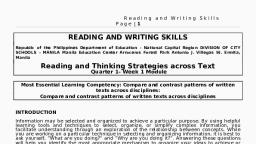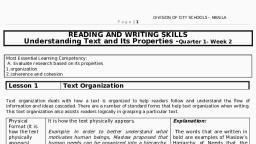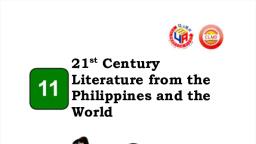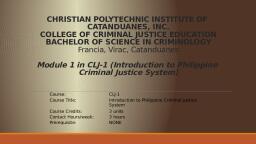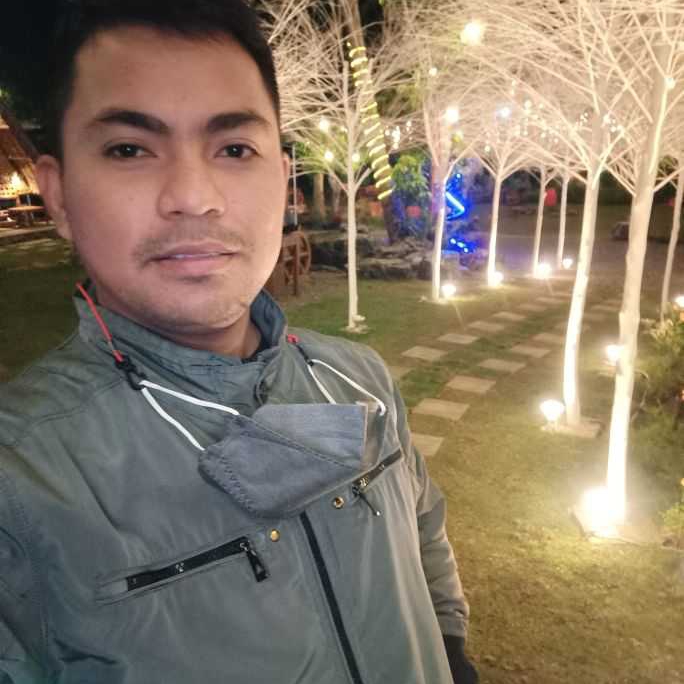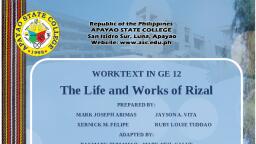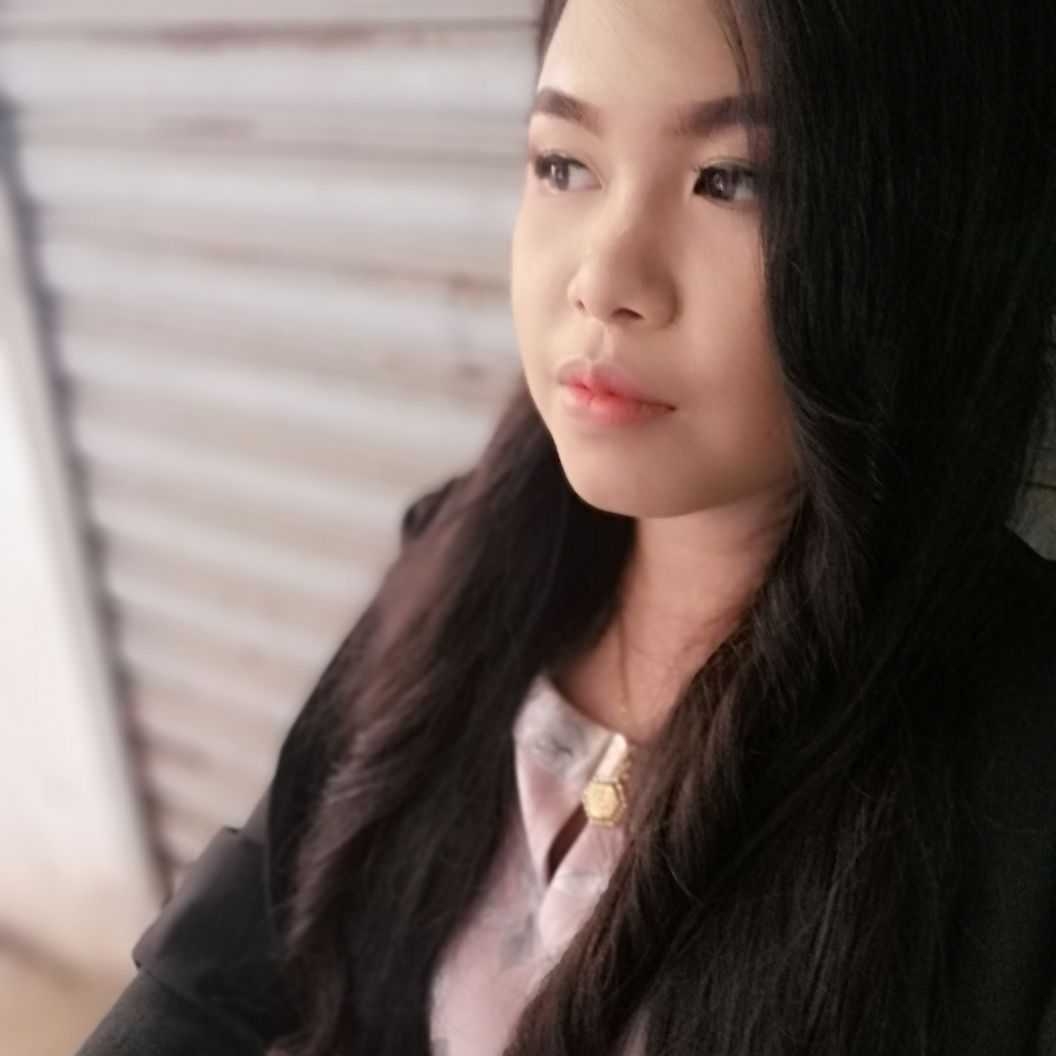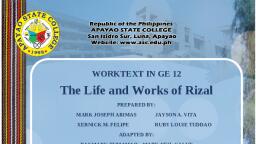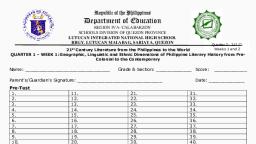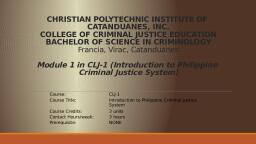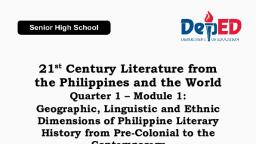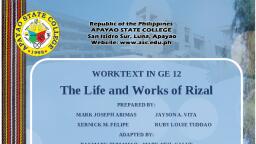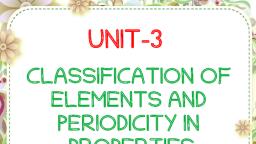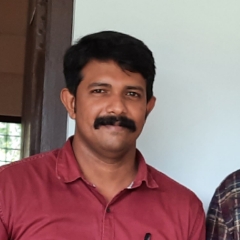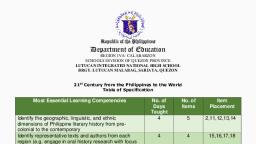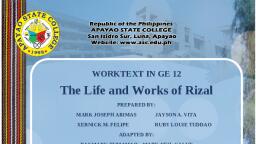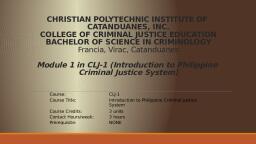Page 1 :
21st Century Literature From the Philippines and the World, Note: Online classes will be done on said time and schedule. Classes will be announced before its execution. Please don’t be late on the scheduled class. Please be attentive and take down notes. All activities can be answered during the discussions and further reading. Be active during classes., The development of Philippine literature extends from pre-colonial period to contemporary period. Each period is reminiscent of literary forms and themes as influenced by the dictates of the era. In this part of the manual, you will understand how Philippine literature developed from the ancient times to the modern days., The beginning period of Philippine literary history can be considered as the longest as evidenced by the artifacts of different periods recovered ranging from 50,000 years ago to 14th century A.D. in the Tabon Cave of Palawan. The said exploration was headed by a team from the National Museum where they found the oldest known human skeletal and fossil in the Philippines. The discovery later on led to the realization of our very own indigenous cultures before the presence of the Spanish colonizers through the analysis of collected oral literature preserved by our Filipino ancestors. Literature during this period may be classified into three groups: folk speech, folk songs, and folk narratives such as riddles, proverbs, myths, legends, fables, and hero tales. Epics are of great proportions among oral literature in all regions., Spiritual traditions and regular trading with our Asian neighbors such as India, China, and other countries from Southeast Asia had been part of our Filipino ancestors' daily lives during the pre-colonial period. As a result, early Filipinos were exposed to various religions and cultures that shaped their values, beliefs, and traditions. Indigenous animism was predominant at the time, but Islam, Buddhism, and Hinduism were also embraced. Other than being one of the largest Christian countries today, our country is also considered as predominantly Islamic since it was introduced in the 14th century as a foreign religion. Although, there was no formal education, early Filipinos already had their own government system. Daily experiences and religious rites and ceremonies mostly reflect the type of literature produced at that time. Experts state the possibility of having our ancestors’ own system of writing during the pre-colonial period but unfortunately only few survived in terms of written form leading to the prevalence of oral literature. This explains why no notable authors were recorded., Certain events in the Philippines during pre-colonial period started to be recorded in the year 1521. Our rich past was reflected in "folk speeches, folk songs, folk narratives and indigenous rituals and mimetic dances that affirm our ties with our Southeast Asian neighbors" (Godinez-Ortega, n.d.)., In terms of government, Filipinos were ruled by chieftains of different barangay. The Malacañang Palace considered this as more on "alliance networking rather than territorial" (malacanang.gov.ph). There was no formal education. Learning was merely through imitation and practice., In general, the following were commonly practiced:, Early Filipinos heavily believed on spirits and supernatural entities (animism)., Social ranking and classes were practiced., Economic and political dimensions involved trading, marriage, feasting, and alliance., Dimensions of Pre-colonial Literature, Philippine literature during the pre-colonial era is mostly based on oral traditions passed down from generation to generation., The language used pertains to daily life., Common forms of oral literature are riddles, proverbs, and songs to express a thought or emotion., Epic was considered as the most exciting poetic and narrative form of literature in which the ASEAN-sponsored study of Filipino asserted that there are more than 100 epics discovered where majority came from Palawan (as cited by Quindoza-Santiago, n.d.). Majority of proverbs, epigrams, and proverbs collected by researchers come from Tagalog, Cebuano, and Ilocano dialects., The ancient pre-Spanish form of writing called Baybayin which was often cited in the work of Pedro Chirino during the 1500s, was later approved as the National Writing System of the Philippines through House Bill No. 1022., The experiences of the people during pre-colonial period such as food hunting, work at home, caring for the children, and creatures or objects of nature served as the common subject in oral literature., Anyone who knew the language and the convention and forms could be a poet, singer, or storyteller., All important events such as rites and ceremonies reflect religious observance where people commonly recite, sing, or utter a chant., Pre-colonial Literary Heritage, Folk Tales. These are stories which can be characterized as anonymous, timeless, and placeless tales circulated orally among a group of people., Legends. These are a form of prose which deal with the origin of a thing, location or name., Myths. Unlike legends where the characters have realistic human qualities, the characters here usually have supernatural powers where the main purpose is to provide explanation about the existence of something or someone., Epics. These pertain to a type of a long narrative poem mainly focusing on the heroic achievements and deeds of the main character. Ex. Biag ni Lam-ang (Ilokano), Hinilawod (Panay) Kudaman (Palawan) Darangen (Maranao). These epics are considered to be the most prehistoric pieces of oral literature (Lumbrera and Lumbrera, 2007), Folk Songs. These can be considered as the oldest forms of Philippine literature that mirror the culture which expresses hopes, aspirations, lifestyles, and emotions of early Filipinos. Some examples are kundiman, kumintang, oyayi or hele and some drinking songs., Riddles (bugtong) are puzzling questions that challenge people’s wits because of their double or veiled meaning. Filipinos, young or old, resorted to riddling as a from of entertainment. It is called Tigmo in Cebu, Paktakon in Ilonggo and Patotdon in Bicol., Proverbs (salawikain) are wise sayings that contain a metaphor used to teach as a food for thought., Tanagas are one stanze poems that consist of usually four lines with seven syllable and all lines observe rhyming., Fantasy Stories are stories that deal with underworld characters., Fables are stories that use animal characters and allegory., Literary Selection, You be acquainted with one Ilokano traditional song intended for courtship. During theearly days, men used to do “harana” whenever they wanted to court women., Pamulinawen (Stone-Hearted Lady), Platform for Discussion, 1.What is the song for?, 2.How does the man pursue the woman, despite her being stone-hearted?, 3.Describe the love of the man towards the woman., 4.Compare and contrast the mode of courtship in the past and at present, Almost half a decade, after the documented discovery of the Philippines in 1521 during Ferdinand Magellan's exploration marks the beginning of the colonial period. The Spaniards successfully colonized the Philippines for more than 300 years having evangelization as its main thrust. The nationalistic consciousness of the Filipinos began when world trade took place in the Philippines as a result of exchanging of liberal ideas with the other countries among children of middle class Filipino families who were sent to Europe. This led to a revolutionary period that ended the long and oppressive Spanish tyranny in our country., American period of colonialism officially took place after Emilio Aguinaldo surrendered. The transition period between Spanish and American colonialism did not run smoothly since resistance among the native Filipinos who were threatened by the coming of other colonizers was evident. The setting of public schools during the American period became a necessary tool for popularizing democracy in our country, training Filipinos for citizenship, and embracing the English language. All of which are considered influential to Philippine literature even up to this date. The last colonizers to enter the Philippines were the Japanese who failed to gain the trust of Filipinos and only lasted for less than five years., Philippine literature had been polished by colonial experiences of Filipinos during Spanish Period, American Period, and Japanese Period. Moreover, foreign encounters with neighboring countries were also significant parts of Filipinos' lives. All of these Eastern (Asia and Middle East) and Western influences (Europe and North America) have uniquely shaped the geopolitical, as well as economic conditions of the Philippines. Eastern culture is more conservative and traditions, while Western culture is liberal, open, and blunt. Great consideration and respect for the elders is emphasized among Asian countries. On the other hand, Europeans and North Americans are quite expressive and have high regards for one's own decision-making., An emphasis on Christian doctrine was manifested through various types of texts which replaced stories about heroes and animated creatures to Biblical characters and saints as evidenced by novenas, prayer books, and other printed materials. This makes literature during the Early Spanish Period didactic or intended for teaching morality and conduct for good behavior. Other than books, plays and dramas emerged for recreational purposes. These were mostly poetic in nature and were intended for public performances. When few privileged Filipino men from middle class families were given access to education, they also became fluent in Spanish language which paved the way to production of literary texts by our own natives. Eventually, this led to reforms in the government through underground newspapers and revolts., Threatened by the presence of other colonizers, the transition between Spanish Period and American Period was not smooth due to resistance among Emilio Aguinaldo who was the appointed president at that time and our fellow countrymen. As compared to Spanish regime, American colonizers used democratic approach as manifested by allowing a Filipino to lead the country through elections where Manuel Quezon won over Aguinaldo. Public education was then emphasized during this period where the English language was introduced and embraced by many Filipinos resulting in various literary works in English which were mostly imitative at first. Some notable Filipino writers later on adapted and developed their own theme, styles, and conventions making their works recognizable both nationally and internationally. Watching foreign films replaced the popularity of theatrical shows and novels., The cruelty of the Japanese occupation was evidenced by strong resistance among the majority of Filipino people. The attempt to erase Western influences was shown when they tried to ban the use of English language during their reign. Freedom of the press and of expression was also suppressed. The Tagalog language was favored by the Japanese which made Tagalog stories and dramas flourish at the time. Love for music was evident through exposure to opera and classical music. Life struggles, nationalism, and patriotism were the common themes and subjects but were secretly published. Only those Filipinos who were living abroad could freely write and express their opinions., I. SPANISH COLONIAL PERIOD (1565-1863), ✔This can be divided into two major periods: Early Spanish Period (1565-1863) and Later Part or Revolutionary Period (1864-1896)., ✔ Early Spanish Period can be categorized as either religious or secular., Dimensions of Philippine Literature, ✔ The type of literature produced during this period used Spanish, Tagalog, and the vernacular form of languages., ✔ Spanish was introduced as the medium of communication and later shifted to Tagalog when a sense of nationalism arose during the revolutionary period., ✔ The introduction of the printing equipment called xylographic press by the Dominicans resulted in publication of various religious materials and earliest books., ✔ Poetically inclined writers led by Tagalog versifiers called Ladinos (natives who were also fluent in Spanish) such as Fernándo Bágongbantâ and Tomas Pinpin tackled mostly morality and religion., ✔ Folk songs still existed., ✔ Drama, as another type of literary genre, as well as metrical tales based on European origin (such as awit and corrido) flourished., ✔ Diaryong Tagalog (1882), a Spanish-Tagalog newspaper, published bulk of Filipino writings. The publication signaled the open campaign for reforms., ✔ In 1889, the La Solidaridad, an underground newspaper, became the mouthpiece of the Reform Movement. Emergence of Other Types of Literature during Spanish Colonial Period, ✔ Books. In 1593, the book written by Fr. Juan de Placencia and Fr. Domingo Nieva entitled "Doctrina Cristiana" (The Christian Doctrine) was first printed. Among the other notable books printed are "Nuestra Señora del Rosario" by Fr. Blancas de San Jose, "Barláan at Jósaphát" (first published in 1708) translated from Greek to Tagalog by Fr. Antonio de Borja, and "Urbana at Felisa" by Modesto de Castro who is considered as the Father of Classic Prose in Tagalog., ✔ Folk Songs. These were songs modified based on the folkways of Filipinos during this period., ✔ Recreational Plays. These were mostly poetic in nature and intended to be performed during the Spanish era. Cenaculo, Carillo, Zarzuela, Moro-Moro, Balagtasan, Duplo, and Karagatan are among the examples., ✔ Novels. These are fictitious prose usually lengthy and complex in nature. Pedro Paterno's work entitled "Ninay" is the first novel published by a Filipino author. This was originally written in Spanish language and translated into English and Tagalog in 1907 and 1908., ✔ Newspapers. There has been a debate on whether newspapers should be categorized as literature or not. However, according to Britannica, some high level journalism like articles written in a newspaper such as columns and feature articles can be considered as literature for as long as they achieve a certain level of satisfaction under aesthetic, chronological, and psychological characterization. Bulk of Filipino writings produced were mostly published in Diaryong Tagalog. The underground newspaper La Solidaridad is considered as the mouthpiece of the Reform Movement., Some Notable Writers, ✔ Francisco Baltazar (1788-1862) was hailed as the "Master of Traditional Tagalog Poetry". His well-known literary work, Florante at Laura (1838–1861), is regarded as the most famous metrical romance of the country., ✔ Pedro Paterno (1857–1911) was the first Filipino who wrote poetry collection in Spanish entitled Sampaguitas y poesias varias (1880). His novel in Spanish Ninay (1885) was considered to be the first Filipino novel., ✔ Jose Rizal (1861–1896), a prominent ilustrado and the country’s national hero, is famous for the novels Noli Me Tangere and El Filibusterismo. These novels portray the corruption and abuse of the Spanish officials and the clergy., ✔ Andres Bonifacio (1863–1897), the founder of the Katipunan, wrote the poem “Pag-ibig sa Tinubuang Lupa” which appeared in the official newspaper of the Katipunan called Kalayaan in March 1896., ✔ Leona Florentino (1849–1884), known as the “Mother of Philippine Women’s Literature,” was a poet in both Ilocano and Spanish. Twenty of her poems were preserved and exhibited in Europe and were included in the Encyclopedia Internationaldes Oeuvres des Femme in 1889., Literary Selection, You will read the English version of Andres Bonifacio’s poem, Katapusan Hibik ng Pilipinas to understand the woes of the Filipinos under the Spanish regime., THE LAST APPEAL OF THE PHILIPPINES, (KATAPUSANG HIBIK NG PILIPINAS), Andres Bonifacio, II. AMERICAN COLONIAL PERIOD (1910-1945), ✔ American colonial period is divided into two periods: the period of apprenticeship (1910-1930) and the period of emergence (1920-1930)., ✔ The surrender of first Philippine President Emilio Aguinaldo in 1901 signified the end of the military struggle for independence., ✔ Aguinaldo promised allegiance to America but still continued to be very vocal of achieving independence for the Philippines., ✔ In 1935, Aguinaldo was soundly defeated by Manuel L. Quezon as the first President of the Commonwealth. Dimensions of Philippine Literature, ✔ During the transition period many Filipino writers still preferred to write in Spanish since English was still a foreign language to them., ✔ Filipino writers were into all forms of literature during the period of apprenticeship but most of their works were critiqued as an imitation of English and American models., ✔ Short stories became the most prevalent literary form during the latter part of American colonial period., ✔ The existence of American literary works and periodicals as well as the coming of American teachers encouraged many aspiring Filipino writers to use the English language., ✔ A new type of literature began when American system of education and English language were introduced., ✔ At the beginning, most of the literary works written in English were considered imitative in nature, but then later on evolved to a new variety of subjects, styles, and conventions of writing., ✔ Common theme in plays was all about nationalism. Other Type of Literature Existed during American Colonial Period ✔ Short Stories. These are stories that can typically be read in one sitting revolving around one subject and may range between 1,000 up to 20,000 words. The first short story written in English is entitled "Dead Stars" by Paz Marquez Benitez. Some Notable Writers, ✔ Juan C. Laya. He won first prize for his novel "His Native Soil" in the First Commonwealth Literary Awards in 1940., ✔ Zoilo M. Galang. His work entitled "A Child of Sorrow" in 1921 is considered as the first Filipino novel in English., Literary Selection, The following essay was written by Francisco Benitez. Read to understand what makes a Filipino educated., What is an Educated Filipino, III. JAPANESE COLONIAL PERIOD (1942-1945), ✔ Japan invaded the Philippines on December 8, 1941 which was strongly opposed by the Guerillas., ✔ Captured soldiers and American deportees were forced to have "Death March" to a prison camp where they walked for 100 kilometers from Mariveles, Bataan to San Fernando, Pampanga. An estimated 10,000 prisoners died here., ✔ Aguinaldo cooperated with the Japanese to end Filipino and American opposition., ✔ Japanese colonizers failed to gain the trust of Filipinos., ✔ The resurgence of World War II forced former President Manuel L. Quezon and Vice-President Sergio Osmeña Sr. to immediately leave the Philippines and sought residence in the United States as the Commonwealth government was suddenly in exile., ✔ There was a great tension between the two major groups: HUKBALAHAP (unified guerilla army against Japanese invasion) and KALIBAPI (political party approved by the Japanese)., ✔ Jose P. Laurel was appointed as the President of the Philippines under the Japanese-sponsored Republic., ✔ In 1942, Mc Arthur escaped but promised to return which he did in 1944. The US victory in the battle of Leyte gulf signaled the beginning of Philippine liberation from the Japanese., Dimensions of Philippine Literature, ✔ All forms of writings were censored during this time because there was no freedom of speech and of the press., ✔ Only those who were living in the United States such as Carlos P. Romulo and Manuel L. Quezon could write freely. ✔ The use of English language was stopped in almost all publications and only Tagalog and the vernaculars were permitted., ✔ Few literary works were printed and mostly considered as pessimistic and bitter according to the author Victoria Abelardo., ✔ Another type of poetry that emerged is the Haiku consisting of three lines with 5-7-5 syllables or 17 syllabic poetry in all., ✔ Tagalog short stories flourished and some of the best works were compiled by the Liwayway magazine editors in Ang Pinakamabuting Maikling Kathang Pilipino ng 1943. Some notable stories were “Lupang Tinubuan” by Narciso G. Reyes, “Uhaw ang Tigang na Lupa” by Liwayway Arceo, “Nayon at Dagat-dagatan” by N. V.M. Gonzalez, and “Suyuan sa Tubigan” by Macario Pineda., ✔ Opera and classical music gained popularity., ✔ Among the other types of literature emerged were essay (e.g. "Literature and Society" by Salvador P. Lopez) and autobiography (e.g. "The Good Fight" by Manuel Quezon)., Some Notable Writers, Carlos P. Romulo. He won the Pulitzer Prize for his notable works such as "I Saw the Fall of the Philippines", "I See the Philippines Rise", "Mother America", and "My Brother Americans"., Narciso Reyes. He won first prize with his short story "Lupang Tinubuan"., As an aftermath of war and a series of foreign invasions in our country, the term post-colonialism was popularized. The lasting impact of imperialism and colonialism had been the utmost concern at this period. American colonial rule already loosened but its influences and control are still somehow affecting us in terms of social, political and economic aspects of our country as manifested in the form of literature produced in various genres., Literary works of Filipino authors started to be recognized through the initialization of Carlos Palanca Memorial Awards in 1950 and realization of the need to grant National Artist Awards in 1972 under the former President Ferdinand Marcos. The influences of Spanish and American cultures can be observed. More and more Filipino writers continued to write more fluently using the English language since gaining independence from the Japanese occupation in 1945. In fact, many of the literary works in both Palanca and Order of National Artists were written in English. Most of these writers were considered as social realists. Short stories became the most popular form of literary expression and more novels were published which mostly dealt with freedom from both economic and political bondage. Social issues such as poverty, survival, gender inequalities, justice system and domestic conditions have been prevalent themes and subjects in literature. Moreover, the leaders of the country have to deal with issues concerning economic stability, new and contrasting ideas, and morality to name a few. The most significant period that greatly influences many Filipinos is the period of Martial Law during the Marcos regime., AFTER THE WAR, ✔ In 1944, Sergio S. Osmeña, Sr. assumed the presidency upon the death of Manuel L. Quezon while the Philippine Commonwealth government was in exile in the U.S., ✔ Manuel A. Roxas defeated Sergio S. Osmeña, Sr. as the President in April 1946 for the Independent Second Republic of the Philippines., ✔ Elpidio R. Quirino assumed the remaining term of Roxas when the latter died of a heart attack in 1948., ✔ In 1953, Ramon F. Magsaysay was elected as the new president but died in an airplane crash on March 16, 1957. ✔ Magsaysay's position was assumed by Carlos P. Garcia who was re-elected and served until 1961., ✔ Diosdado P. Macapagal became the President after Carlos P. Garcia. He changed the date of Philippine Independence from July 4, 1946 (Liberation from America) to June 12, 1896 (Liberation from Spanish by the revolutionists). He also recognized the presidency of Jose P. Laurel., PHILIPPINES DURING THE MARTIAL LAW PERIOD, ✔ Ferdinand E. Marcos took office for presidency in 1965 who got re-elected in 1969 making him the first to win two presidential terms., ✔ He declared Martial Law on September 21, 1972 and led the country into what he calls "The New Society" against lawlessness which incited a lot of opposition., ✔ Marcos was forced to hold an election in 1978 and 1981 to stabilize the country's chaotic condition where he won again., ✔ The death of Benigno Simeon "Ninoy" Aquino, Jr. became the beginning of calling for Marcos' removal., ✔ EDSA People Power Revolution (bloodless revolution) through the initiative of Maria Corazon C. Aquino and her supporters erupted which marked a significant national event., ✔ Snap election was conducted in 1986 which seated Corazon Aquino- the widow of Benigno Simeon "Ninoy" Aquino, Jr. as the 11th President of the Philippines and ended the 21 years of what many claimed as the tyrant rule., ✔ Marcos went on exile in Hawaii, where he died on September 28, 1989., PHILIPPINES AFTER THE MARTIAL LAW PERIOD (5TH REPUBLIC/1986 TO PRESENT), ✔ The political and economic condition of the Philippines during Cory Aquino's administration was described as chaotic. ✔ Monopolization of the agricultural industry took place after the International Monetary Fund (IMF) forced the Philippines to pay its debt amounting to 27.2 billion dollars which they claimed to be inherited from Marcos administration., ✔ Fidel V. Ramos (also known as "Centennial President") took office in 1992 where he immediately worked on the country's recovery. He was awarded the Peace Award by UNESCO in his effort to achieve a Peace Agreement with MILF. ✔ Film actor Joseph Ejercito Estrada won presidency with his pro-poor campaign in1998 but was ousted in 2001 because of corruption and gambling issues., ✔ Maria Gloria Macapagal Arroyo assumed office in 1998, got re-elected, and served until 2010. During her term, many impeachment complaints were filed against her due to corruption and electoral sabotage where she got hospital arrest for her spinal surgery., ✔ Former Senator Benigno Simeon C. Aquino III (aka PNoy or Noynoy Aquino) seated as the next president in 2010., ✔ Next to him is our current President- Rodrigo Roa Duterte who is both a lawyer and politician., Dimensions of Philippine Literature, ✔ Filipino writers began to develop new themes, styles, and techniques. The first notable work that appeared right after the second world war under Japanese occupation in the Philippines is a novel written by Macario Pineda entitled Ginto sa Makiling which was considered as a narrative of the Philippines’ social, political, and moral aspects (Macansantos, et al, n.d.). It was noted for its resemblance to the work of Rizal and more on the work of Balagtas in terms of plot and style., ✔ The rise of English writers began after exposure to American language and culture, although there were still many Filipino writers observed using the vernaculars. Sarvia (n.d.) considers the following factors contributory to the flourishing of Filipino literature:, establishment of the University of the Philippines in 1908 where English was primarily used as the medium of instruction,, the founding of the Philippine Writers’ Association in 1953, and, the establishment of the Carlos Palanca Memorial Award in 1955 to name a few., ✔ According to Macansantos et al (n.d.), among the common literary themes in novels and short stories were war experiences which can be seen in the works of Stevan Javellana’s Without Seeing the Dawn (1947) and Edilberto Tiempo’s Watch in the Night for the English category. While for Filipino literature that used the vernaculars, the works of Lazaro Francisco were profoundly noted for his style associated to Rizal’s influence such as Bayaning Nagpatiwakal (1932), Sugat sa Alaala (1950), Maganda pa ang Daigdig (1956), and Daluyong (1962). The influence of both Spanish and American styles could be observed in the work of Nick Joaquin where his flashback technique was highly appreciated by critics. Some writers attempted to incorporate a taste of folk tradition especially in poetry such as epic and other oral forms of literature which still existed like Balagtasan. However, oral tradition became less popular as people became more interested in short stories., Literary Selection- Short Story 1, Read the following stories before doing the activities:, THE WHITE HORSE OF ALIH, By: Alvarez Enriquez, The story happened on July 4th in a city with a parade of people. It was a happy day for everybody because they are celebrating the big American Holiday. Among the crowd was Alih, a Moro who was then looking for his brother, Omar. That day was intended for them to fulfill their plan. Their plan is to kill these people., So Alih waited for his brother, he went out of the crown and sat under the Balete tree. While he was sitting and looking at the parade, he remembered his past, his childhood and his growing years where he met the women whom he wished and longed for and he remembered his mission. That is—to kill the people. But people can’t notice them as Moros because they were in disguise., When he saw a man riding a horse and controlling the crowd, he remembered how much he longed for a horse for himself. He recalled when his brother punished him because he spent his earnings just to ride in a merry – go- round. He wanted to ride on a wooden horse because he saw the girl whom he liked most and her name was Lucy. Lucy was the girl who lived in the reservation area where the Americans live. Moros were not allowed to enter that vicinity. But because he needs to go to school, he cross the river and reached the reservation area. There he saw the first girl he liked. Though, they were not given the chance to see and talk to each other since then., When he grew up, Omar told him about how the American soldiers killed their father without any reason. Their father was known and respected in their village. With these, Omar taught him to be brave and be able to fight against these people because he believes that only by killing could they wash away their shame. He taught him words to live by and beliefs to be respected and attained., As he grew into a mature individual, he met another woman named Fermina. Fermina was a beautiful bar maid with a mole near her mouth. He likes her so much but the woman doesn’t like him because of his impertinent manner towards her. He was put to jail for six months because of what he did., Remembering all of these from his past, he thought of what Omar said about the promise of their prophet to those who are faithful to him. That is to have a white horse ride to heaven and as many hours as the number of infidel heads he could lay before Allah. But when he thought of what their Imam said that white horse, as a reward for killing is an reference conjured by fanatics in their attempt to give reason to their behavior. The prophet never taught them about that because he was man of peace., So back to reality, he continued searching for Omar into the crowd. Soon he saw a float with a girl whom he thought of as Fermina. He went near the float and assisted the girl to go down to the ground. As he was about to hold her completely, Omar came but to his surprise, he was drunk and tipsy! All along, he realized that Omar had been drinking tuba. He knew that Omar was afraid to kill that is why he drink tuba first before he go to the town., Omar shouted and leap to the street, and then he gets his fatal blade from his pants., The crowd screamed. Fear and panic seized everyone. Everyone is running and escaping from Omar, even fermina jumped into the ground and run away but she got stocked from a bamboo frame of the float because of her long flowing robe that hooked on the edge of the bamboo frame. She tried to set her free but she saw Omar coming to her swinging his blade. Fermina screamed and screamed because of fear., The screams struck Alih because he saw that Fermina the girl he was love is in danger and get his blade from his leg immediately and then he leaped to his brother Omar and hit its back by his sharp blade repeatedly. Omar died., The town spoke out about the strange tragedy for many days after. But nobody had known Alih, and nobody could figure out why he turned against his brother. -, Literary Selection- Short Story 2, NOTE:, Attend to the discussion every Wednesdays at 9:00-10:00, please be attentive and take down notes. Answer the activities in the activity sheet given. All answers must be written in a yellow pad, except for activities instructed to be done in an A4 bond paper ONLY. Please follow the instructions., Activities:, 1. During the pre-colonial period, our ancestors attempted to provide an explanation of anything that they encountered through myths and legends. What story or stories do you know about how the world began? Read at least two retold versions from different regions. Compare and contrast the two versions using Venn diagram. What is it that you found puzzling, interesting, intriguing, or strange in the story? Is it similar to your belief of how the world began? Why or why not? Use A4 bond paper., 2. List down a compilation of your most valued words of wisdom that you often hear from your parents, grandparents, other elders in the family, or any most influential people in your life. Explain how these words of wisdom helped or guided you in many ways., 3.Read the essay “What is an Educated Filipino by Francisco Benitez and answer the following: Essay is posted in the GC/Teachmint., What are the qualities of an educated Filipino?, In what way can a Filipino Demonstrate such qualities?, How can a Filipino live up to these qualities in this contemporary time?, 4. Recall a fearful creature that you have heard from any Pinoy urban legends. Draw its physical description and tell how you feel about it. Use A4 bond paper for this activity., 5. Complete the word by filling in the missing letters., Performance Tasks:, 1.Read the poem “The Last Appeal of the Philippines-Katapusang Hibik ng Pilipinas” by Andres Bonifacio. Perform the following: 10pts (Poem posted in the GC/Teachmint/Learning Material), A., Who is the “mother” the persona is talking to?, What is the tone of the poem?, Discuss the heartbreaking experiences of the Filipinos during the Spanish rule., In what way is nationalism depicted in the poem?, If you relate the poem in the Philippine society today, what could also be your appeal to the Philippines?, B. In groups of three (3), pick one stanza from the poem and illustrate the scence in a 1/8 illustration board. Make your artwork vivid and eye-catchy. Explain your work during submission. 30pts, Rubric:, Relevance of the artwork to the theme - 10, Creativity -10, Presentation - 10, Total - 30, 2.Write your own version of a real hero story. You may do a comic book of it. 10pts (A4 bond paper), 3.Create linguistic or ethnic groups in your class (6 members in each group) and research for a folk song of your community. Rehearse it well because you will be render the song to your class. You may use a musical instrument. After the rendition, your leader briefly explains the meaning.25pts. Rendition is to be performed and recorded during online class., Rubric:, Rendition of the song -10, Explanation - 10, Vocal Quality - 5, Total - 25, 4. Read the story “The White House of Alih” by E.A. Enriquez. (Story is in the learning material/teachmint/GC or open the link- ) Use the table below to present the different elements of the literary piece.




